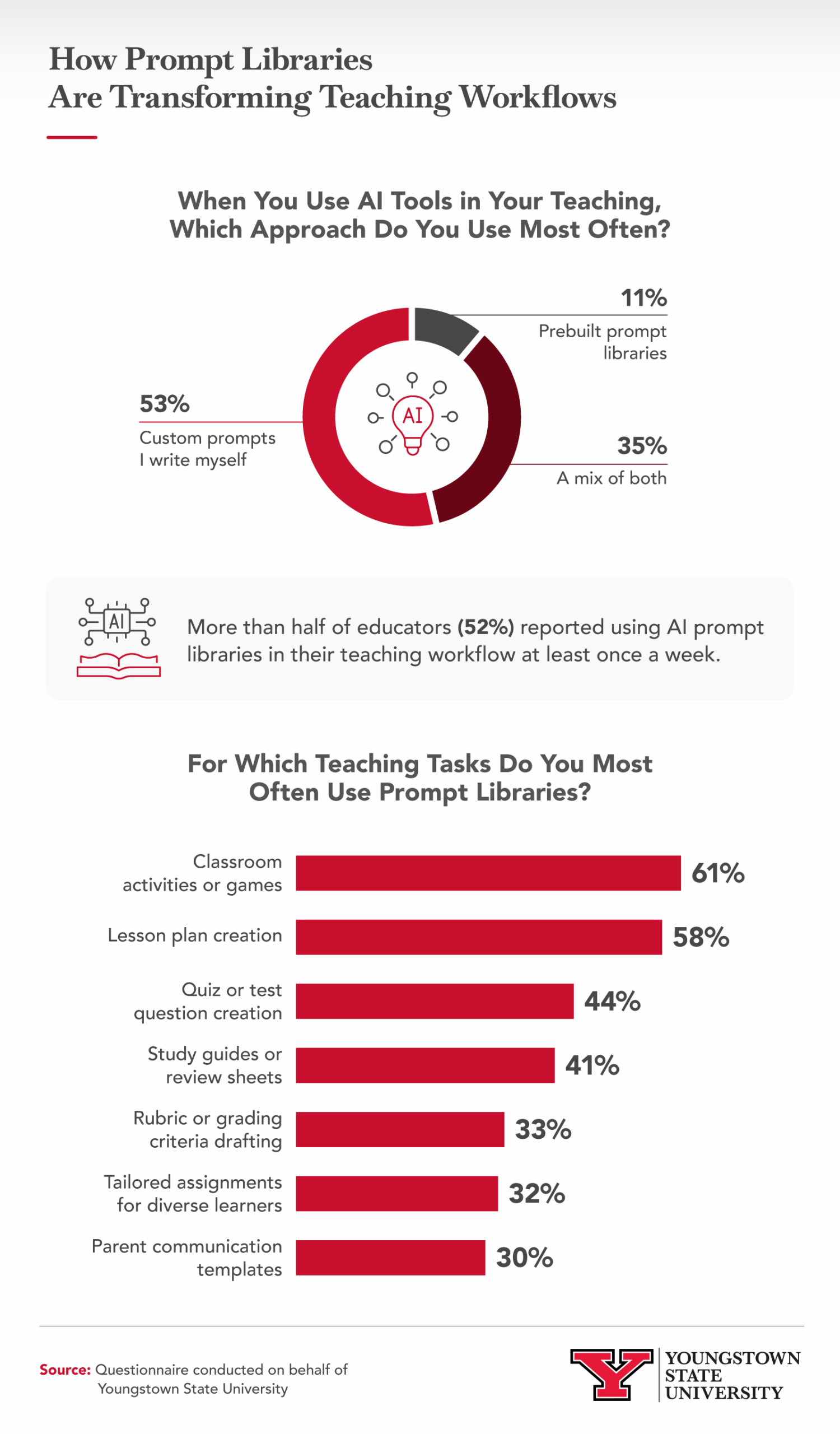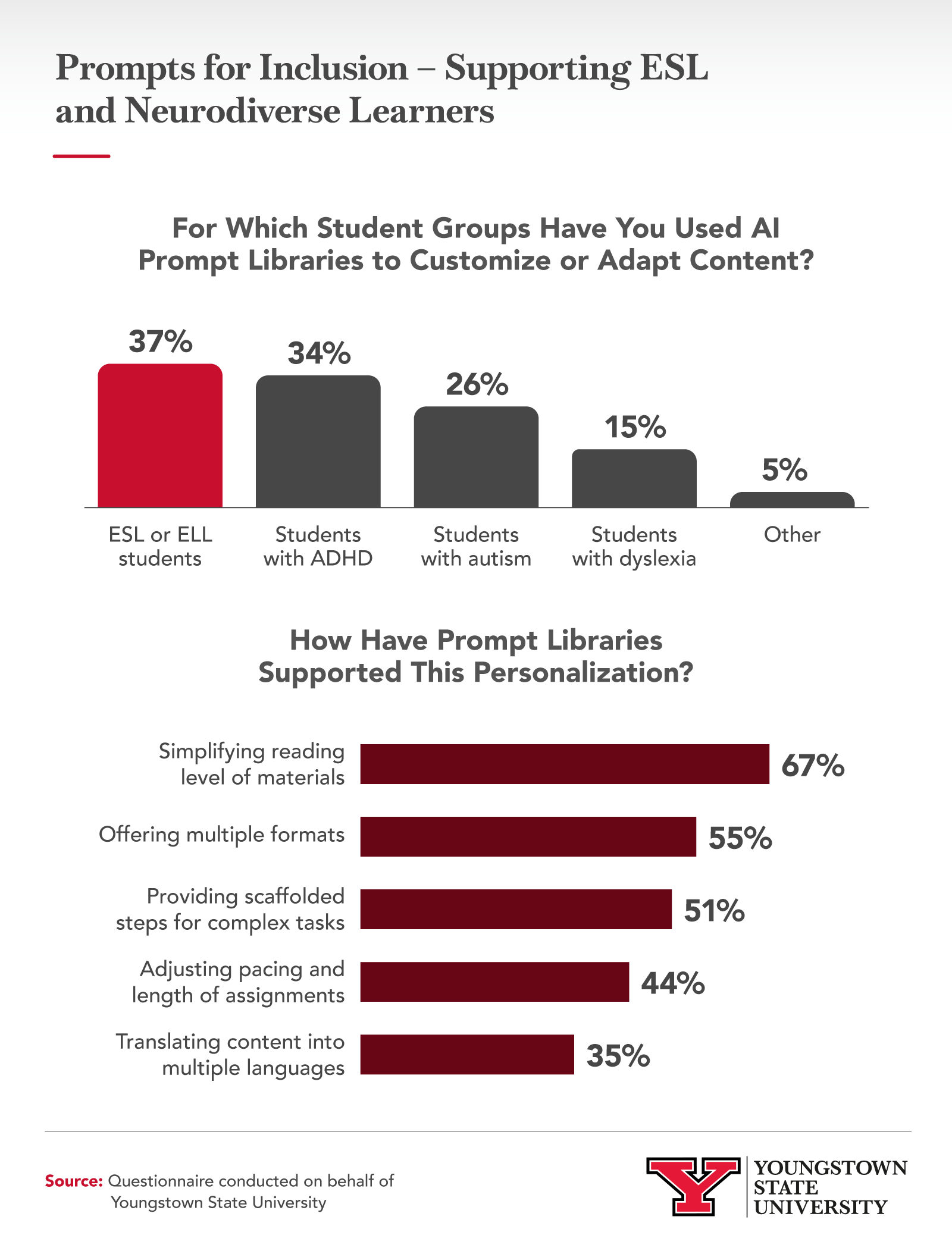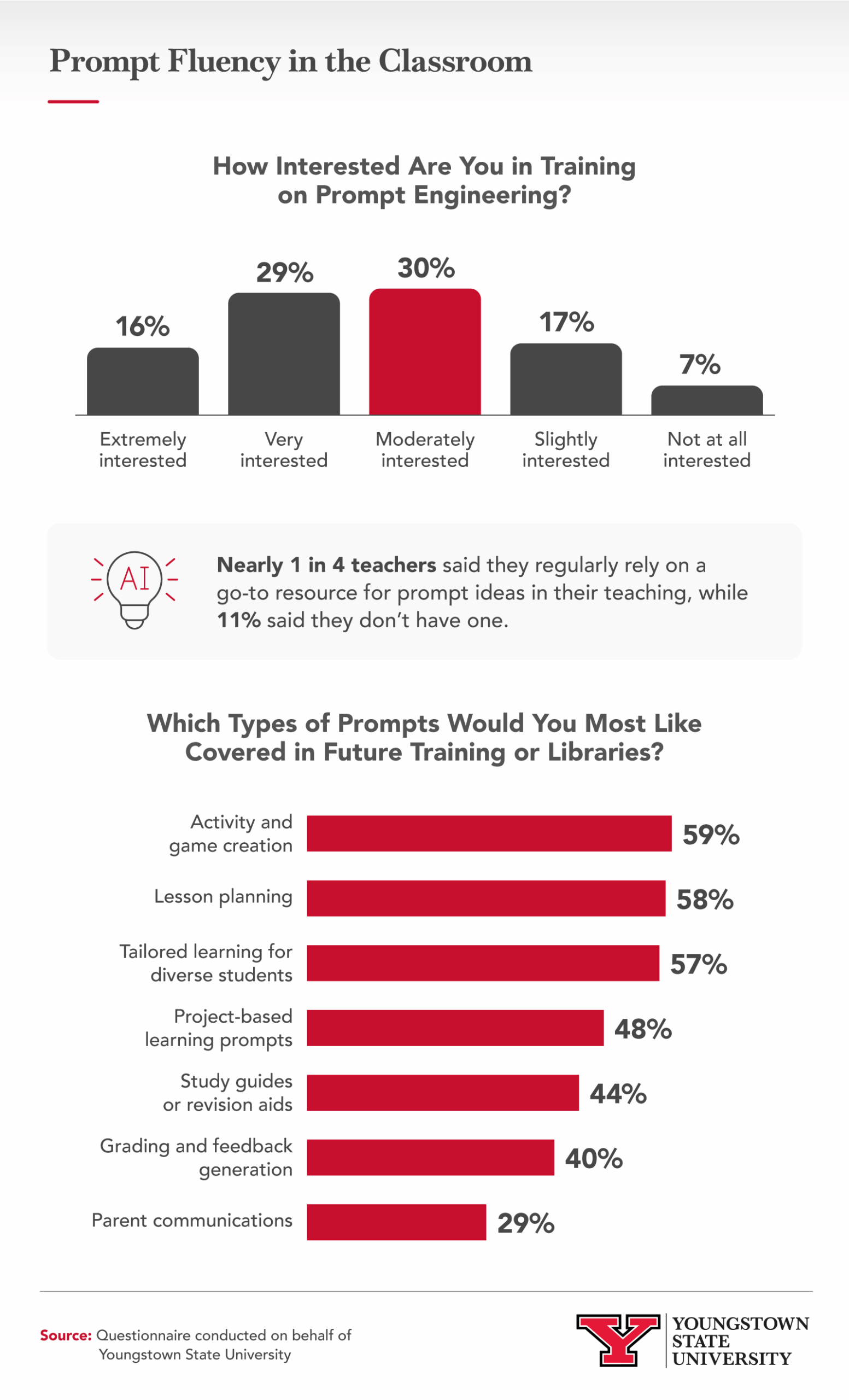
Artificial intelligence (AI) is rapidly reshaping classrooms, offering new ways for teachers to design lessons, personalize instruction and save time on daily tasks. One of the most significant tools emerging in this space is the AI prompt library, a collection of ready-made or customizable inputs that guide generative AI platforms like ChatGPT to produce useful teaching resources. From lesson plans to classroom activities, these libraries are helping educators experiment with AI for education in more structured and effective ways.
To better understand how teachers are utilizing these tools, a national questionnaire of 322 K-12 and higher education instructors was conducted on behalf of Youngstown State University (YSU). Respondents came from across the U.S. and shared how often they used AI prompt libraries, where they applied them in their workflows and what kind of training they still needed. This questionnaire was designed to better prepare current teachers and future graduate students with insights that connect directly to the realities of today’s classrooms.
To enrich these findings, research insights about AI in education from other leading organizations were added to this report. Together, these sources reveal how educators are adopting GenAI in the classroom. They also highlight what this shift means for both practicing teachers and graduate students who want to stay on top of technology in schools.
Key Takeaways
- More than half of educators (52%) report using AI prompt libraries in their teaching workflow at least once a week.
- The top teaching tasks where educators use prompt libraries are classroom activities/games (61%) and lesson plan creation (58%).
- One-third of teachers are introducing students to prompt writing.
- 75% of teachers are interested in training on prompt engineering.
- Over half of teachers (57%) want future training or prompt libraries to focus on tailored learning for diverse students.
Teacher Adoption and Workflows
Teachers are beginning to use AI prompt libraries as a practical tool to make their work easier. Instead of starting from scratch every time they open a generative AI tool, these libraries give them a reliable starting point with ready sets of ideas, instructions or examples for creating lesson plans, study guides or classroom activities. In many ways, a prompt library works like a digital toolbox, helping teachers save time, stay organized and keep students engaged.

More than half of educators (52%) reported using an AI prompt library in their teaching workflow at least once a week. These libraries have most often been used for creating classroom activities or games (61%), lesson plans (58%), and quizzes or tests (44%). Teachers can also use prompts to brainstorm activities, design icebreakers or create interactive role-play scenarios. These examples show that prompt libraries are flexible enough to support a wide range of teaching strategies, from planning to active learning.
When it came to student use of AI tools during lessons, practices varied widely. Teachers reported that 4% of their students used AI daily, while 26% engaged with it weekly and 18% monthly. About half of their students used AI rarely (30%) or never (21%). Nearly one-third of educators (29%) said AI use was not permitted in their classrooms. Among those who did allow it, 43% guided students with structured tasks, while 28% gave students the option to explore AI on their own.
The study also found that one-third of teachers have introduced students to prompt writing. Within that group, 28% of educators said they occasionally teach students how to craft effective AI prompts, while 4% reported doing so regularly. However, 42% of educators said they have never taught students how to write prompts.
National Studies Show Varied Patterns of AI Use
A 2025 RAND survey of K-12 teachers and principals in the U.S. revealed that one-quarter of teachers used AI tools during the 2023-2024 school year, with most using them primarily for instructional planning (64%). The same report found that nearly 40% of English language arts and science teachers reported using AI, compared to just 20% of general elementary and math teachers. It also noted that those in higher-poverty schools were less likely to use AI tools or receive institutional guidance, compared to their peers in schools with less poverty.
A more recent study from Gallup and the Walton Family Foundation questioned over 2,000 US teachers working in public K-12 schools about AI use during the 2024-2025 school year. Their results showed an uptick in AI use, with 60% of teachers reporting using AI at least once. Yet, only 19% reported that their school has a formal AI policy in place. It appears that institutional guidance hasn’t kept pace with classroom use, which may help to explain why teachers’ approaches to AI range from enthusiastic adoption to strict avoidance.
Gallup also noted that three in 10 teachers who used AI tools weekly reported saving an average of 5.9 hours per week. Researchers estimated that this amounts to six weeks saved over the course of a school year. Teachers said they reinvested this time into more personalized instruction, providing deeper feedback on student work and improving communication with families.
Personalization for Learners
One of the most promising uses of AI prompt libraries is their ability to help teachers adapt lessons for students with different needs. Whether supporting English learners or those on individualized education programs (IEPs), AI can offer tailored resources that strengthen teaching strategies and create more inclusive learning environments. For many educators, these tools serve as a bridge, helping them design materials that are both accessible and engaging for every student.

Teachers said they most often use AI prompt libraries to customize or adapt content for English as a Second Language (ESL) or English Language Learner (ELL) students (37%), students with ADHD (34%) and students with autism (26%). These adaptations included simplifying reading levels (67%) and offering content in multiple formats such as text, audio or visuals (55%). Teachers emphasized that these tools can support special education planning, but they also came up against significant challenges.
More than one-third (36%) said prompts were not easily adjustable to meet the needs of individual learners. Others noted issues with clarity (33%), citing that prompts often included jargon that students could not understand. Relevance was also a concern, with 30% reporting limited cultural representation in the outputs, which raised inclusivity issues.
And even though 51% of teachers said prompt libraries helped scaffold lessons into smaller steps, 22% felt that it was too shallow. Similarly, while 35% appreciated translation into multiple languages, 21% said multilingual support was still lacking.
Global Research on AI and Inclusive Learning
Microsoft’s 2025 AI in Education Special Report showed that teachers worldwide are using AI tools to bridge language barriers and improve inclusivity in schools with diverse populations. Translation features and adaptive content helped students participate more fully in multilingual classrooms, and schools that adopted AI for accessibility reported stronger student confidence, especially among learners who previously felt excluded from discussions.
A separate survey of college students with disabilities in the UK found that generative AI chatbots supported them by summarizing texts, structuring assignments and rewriting material. Students said these tools improved their critical thinking, helped them meet learning objectives and made it easier to manage academic demands.
Training and Prompt Fluency
As AI tools become more common in classrooms, many teachers are eager to build confidence in using them effectively. The questionnaire conducted on behalf of YSU found that 75% of educators wanted more training on prompt engineering, which refers to the skill of writing and refining precise instructions so that AI generates useful and reliable results.
More than half (57%) also wanted future training or AI prompt libraries to focus on tailoring lessons for diverse learners. Teachers recognize that while prompt libraries already save time and improve classroom management, stronger skills will help them apply the technology to high-quality instructional goals.

Teachers looking to strengthen their prompting skills can start with advice from the creators of the popular chatbot ChatGPT. OpenAI Academy has shared six practical strategies for getting better AI outputs in the classroom. They include:
- Write clear instructions: Precise, specific prompts yield more relevant and usable responses.
- Provide reference texts: Sharing sample texts or style guides helps AI mirror the desired tone, complexity and phrasing.
- Split complex tasks into smaller steps: Breaking down multifaceted tasks improves accuracy and depth.
- Give the model time to process: Encouraging step-by-step reasoning enhances accuracy for complex queries.
- Upload external materials: Incorporating lesson plans, handouts or templates provides context for more relevant responses.
- Test prompts with varied inputs: Iterative testing ensures robustness and broad applicability across classrooms.
Each strategy offers teachers a stronger starting point for adapting AI to a specific topic, whether they are creating learning activities, designing a research project or guiding students through assignments.
What AI Prompt Libraries Mean for the Future of Education
AI is quickly moving from an experimental tool to an everyday resource in classrooms. The findings from YSU’s questionnaire show that teachers are using prompt libraries to save time, adapt lessons and strengthen their teaching strategies. At the same time, educators need more training so they can apply AI in ways that are inclusive, sustainable and grounded in real-world needs. With growing interest in GPT, Gemini and other platforms, teachers and future graduate students will benefit from understanding how to use these tools for high-quality instruction and stronger student outcomes.
Looking ahead, AI will not replace the expertise or creativity of teachers. Instead, it will give educators more space to focus on supporting students, building connections and using student data to personalize learning. By investing in training and embracing AI responsibly, schools and universities can prepare teachers to use prompt libraries as powerful supports for learning activities, inclusive instruction and meaningful classroom experiences.
Methodology
A questionnaire of 322 K-12 and higher education teachers across the U.S. was conducted on behalf of YSU to explore the adoption, usage and training needs related to AI prompt libraries and generative AI tools in K-12 and higher education. This is a non-scientific, exploratory study designed to explore behavioral and attitudinal trends. It is not intended to represent all K-12 and higher education teachers.
The questionnaire findings were supplemented with secondary data from authoritative sources, including RAND (2025), Gallup (2025), Microsoft (2025), ScienceDirect (2025) and OpenAI Academy (2025) to contextualize adoption trends and provide further information.
About Youngstown State University
Youngstown State University offers accelerated, fully online Master of Science in Education (M.S.Ed.) programs to help educators adapt to a rapidly changing educational environment online. These programs allow students to earn their degree in as few as 12 months, balancing affordability and real-world application through pay-by-the-course tuition. Taught by practitioner faculty, the curriculum is tailored so educators can immediately apply what they learn in their own classrooms and communities.
Fair Use Statement
The information in this article may be shared for noncommercial purposes only. If you reference or republish this content, please provide proper attribution and a link back to Youngstown State University.


